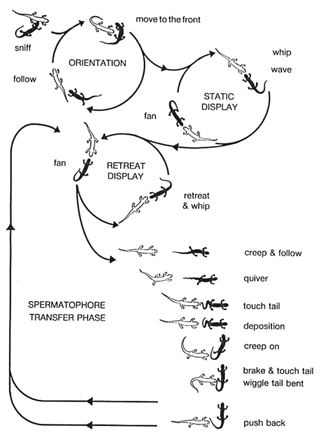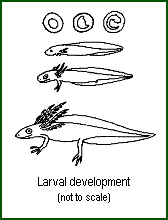REPRODUCTION IN TRITURUS
LIFE CYCLE
Newts of the genus Triturus follow the
familiar cycle of amphibian reproduction; they enter waterbodies
to breed in the spring, and lay eggs which hatch into 'tadpoles'.
The 'tadpoles' then metamorphose later in the season, and the
young newts leave the water until they are old enough to breed.
BREEDING
The genus Triturus shows a remarkable
degree of sexual dimorphism, and males may appear strikingly
different from females. When in breeding condition, males of most
species develop crests on their backs and tails, and may also
become more brightly coloured than when on land. Their cloaca
also becomes heavily swollen. Females usually appear very fat, as
they may be carrying up to 400 eggs.
 Unlike
most frogs and toads, these newts lack a courting embrace (amplexus).
The males, after a courtship 'dance' deposit a package of sperm (a
spermatophore) on the substrate, and lead the female over it. She
then takes the spermatophore into her cloaca, and fertilization
takes place internally.
Unlike
most frogs and toads, these newts lack a courting embrace (amplexus).
The males, after a courtship 'dance' deposit a package of sperm (a
spermatophore) on the substrate, and lead the female over it. She
then takes the spermatophore into her cloaca, and fertilization
takes place internally.
There are several elements to the courtship
dance. These have been described by Arntzen & Sparreboom (1989),
and vary from species to species. The display of T. vulgaris,
T. helveticus and T. montandoni is
diagramatically represented to the right, as shown in Arntzen and Sparreboom's paper.
The main elements are orientation, static
display, retreat display and spermatophore transfer. In the
orientation phase, the male positions himself in front of the
female, after having ascertained that she is a female of his
species. In the static display phase, he attracts her attention
by means of body, tail, and crest movements. If she approaches
him, he may move into the retreat display phase, continuing to
display while maintaining his position relative to the female.
When the male receives the signal that the female is ready, they
will move into the spermatophore transfer phase, where the male
deposits a spermatophore, and leads the female into the correct
position to take it into her cloaca.
Static and retreat display elements are
described by Arntzen and Sparreboom as:
'Fan': the male folds his tail back
along the side nearest to the female he is displaying to, and
beats it rapidly.
'Wave': the male holds out his tail to give the female a
view of one side of his body and tail.
'Whip': the male violently lashes his tail against his
side, to send a wave of water towards the female.
'Flick': an outward curling movement of the tail, less
rapid and controlled than the 'fan'.
'Lean-in': the male stretches his legs, and slightly
arches his back, to lean over the female.
'Cat-buckle': arching of the back. The 'lean-in'
incorporates a 'cat-buckle'.
'Rocking': a complex
movement, involving rocking from side to side, while coiling and
uncoiling the tail on alternate sides.
'Head-bobbing': a rapid bobbing up and down of the head,
which also causes vibration of the crest.
'Flurry': a rapid vibratory movement of the tail to the
side facing away from the female.
'Wiggle tail bent': a slow worm-like undulation of the
tail tip.
'Flamenco': a raising of the tail to an almost vertical
position, with a wiggling of the tail tip.
Spermatophore transfer phase elements are
described as:
'Creep': the male walks slowly in
front of the female, with his body close to the ground, and his
head slightly raised, undulating his tail.
'Touch-tail': the female touches the male's tail with
her snout. This is the trigger for spermatophore deposition.
'Brake': after spermatophore deposition, the male creeps
forward, then turns to one side, with his tail against his body,
undulating the tip. This blocks the female's movement.
'Push-back': in the 'brake' position, the male pushes
the female back slightly, by a small straightening of his tail.
After fertilization, the female will begin to
lay eggs; these are usually laid singly, on the leaves of water
plants, which are then wrapped around the egg. The sticky egg
will 'glue' the leaf around it, thus hiding the egg from
predators. In the absence of water plants, eggs may be laid on
any available surface. Egg laying may last from from a week to
several months.
DEVELOPMENT
 An egg may take up to a few
weeks to hatch, depending on temperature, and a tiny, slim-bodied
larva (although the word 'tadpole' is sometimes used to describe
newt larvae, this word is really only applicable to frog and toad
larvae) will emerge. Newt larvae are almost exclusively
carnivorous, and will feed on anything that moves, and will fit
inside their mouths. The larvae look somewhat similar to fish in
shape, but have large feathery gills on each side of their head.
Over a period of a few months, they will grow legs (front legs
first, unlike frog and toad larvae), and eventually will lose
their gills, start breathing air, and will leave the water.
Occasionally, some larvae will fail to metamorphose in this
manner, and keep on growing in the larval stage. This is known as
'neoteny'.
An egg may take up to a few
weeks to hatch, depending on temperature, and a tiny, slim-bodied
larva (although the word 'tadpole' is sometimes used to describe
newt larvae, this word is really only applicable to frog and toad
larvae) will emerge. Newt larvae are almost exclusively
carnivorous, and will feed on anything that moves, and will fit
inside their mouths. The larvae look somewhat similar to fish in
shape, but have large feathery gills on each side of their head.
Over a period of a few months, they will grow legs (front legs
first, unlike frog and toad larvae), and eventually will lose
their gills, start breathing air, and will leave the water.
Occasionally, some larvae will fail to metamorphose in this
manner, and keep on growing in the larval stage. This is known as
'neoteny'.
NEOTENY
Neoteny is the retention of
juvenile characters into the adult stage of life. This is
occasionally seen in some Triturus species, particularly T.
alpestris and T. vulgaris. The most obvious
manifestation of neoteny is retention of gills in the adult,
necessitating a totally aquatic lifestyle. Some neotenous newts
become sexually mature, and are able to reproduce (total neoteny).
REFERENCES
Arntzen, J. W. & Sparreboom, M.,
1989. A phylogeny for the Old World newts, genus Triturus:
biochemical and behavioural data. Journal of Zoology 219:
645-664. [ABSTRACT]

 Unlike
most frogs and toads, these newts lack a courting embrace (amplexus).
The males, after a courtship 'dance' deposit a package of sperm (a
spermatophore) on the substrate, and lead the female over it. She
then takes the spermatophore into her cloaca, and fertilization
takes place internally.
Unlike
most frogs and toads, these newts lack a courting embrace (amplexus).
The males, after a courtship 'dance' deposit a package of sperm (a
spermatophore) on the substrate, and lead the female over it. She
then takes the spermatophore into her cloaca, and fertilization
takes place internally.  An egg may take up to a few
weeks to hatch, depending on temperature, and a tiny, slim-bodied
larva (although the word 'tadpole' is sometimes used to describe
newt larvae, this word is really only applicable to frog and toad
larvae) will emerge. Newt larvae are almost exclusively
carnivorous, and will feed on anything that moves, and will fit
inside their mouths. The larvae look somewhat similar to fish in
shape, but have large feathery gills on each side of their head.
Over a period of a few months, they will grow legs (front legs
first, unlike frog and toad larvae), and eventually will lose
their gills, start breathing air, and will leave the water.
Occasionally, some larvae will fail to metamorphose in this
manner, and keep on growing in the larval stage. This is known as
'neoteny'.
An egg may take up to a few
weeks to hatch, depending on temperature, and a tiny, slim-bodied
larva (although the word 'tadpole' is sometimes used to describe
newt larvae, this word is really only applicable to frog and toad
larvae) will emerge. Newt larvae are almost exclusively
carnivorous, and will feed on anything that moves, and will fit
inside their mouths. The larvae look somewhat similar to fish in
shape, but have large feathery gills on each side of their head.
Over a period of a few months, they will grow legs (front legs
first, unlike frog and toad larvae), and eventually will lose
their gills, start breathing air, and will leave the water.
Occasionally, some larvae will fail to metamorphose in this
manner, and keep on growing in the larval stage. This is known as
'neoteny'. 